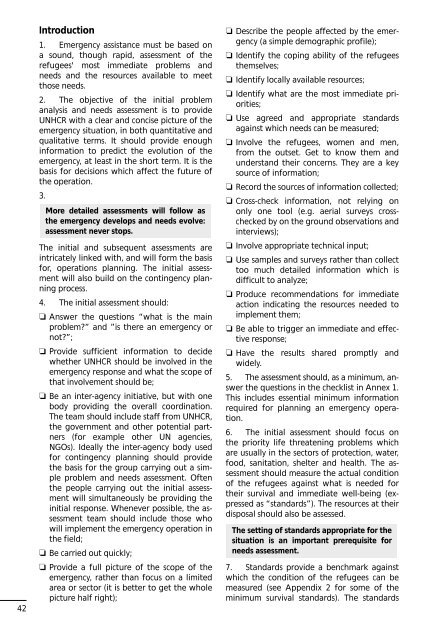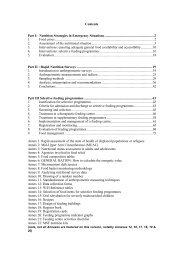UNHCR Handbook for Emergencies - UNHCR eCentre
UNHCR Handbook for Emergencies - UNHCR eCentre
UNHCR Handbook for Emergencies - UNHCR eCentre
You also want an ePaper? Increase the reach of your titles
YUMPU automatically turns print PDFs into web optimized ePapers that Google loves.
42<br />
Introduction<br />
1. Emergency assistance must be based on<br />
a sound, though rapid, assessment of the<br />
refugees' most immediate problems and<br />
needs and the resources available to meet<br />
those needs.<br />
2. The objective of the initial problem<br />
analysis and needs assessment is to provide<br />
<strong>UNHCR</strong> with a clear and concise picture of the<br />
emergency situation, in both quantitative and<br />
qualitative terms. It should provide enough<br />
in<strong>for</strong>mation to predict the evolution of the<br />
emergency, at least in the short term. It is the<br />
basis <strong>for</strong> decisions which affect the future of<br />
the operation.<br />
3.<br />
More detailed assessments will follow as<br />
the emergency develops and needs evolve:<br />
assessment never stops.<br />
The initial and subsequent assessments are<br />
intricately linked with, and will <strong>for</strong>m the basis<br />
<strong>for</strong>, operations planning. The initial assessment<br />
will also build on the contingency planning<br />
process.<br />
4. The initial assessment should:<br />
apple❏ Answer the questions “what is the main<br />
problem?” and ”is there an emergency or<br />
not?”;<br />
apple❏ Provide sufficient in<strong>for</strong>mation to decide<br />
whether <strong>UNHCR</strong> should be involved in the<br />
emergency response and what the scope of<br />
that involvement should be;<br />
apple❏ Be an inter-agency initiative, but with one<br />
body providing the overall coordination.<br />
The team should include staff from <strong>UNHCR</strong>,<br />
the government and other potential partners<br />
(<strong>for</strong> example other UN agencies,<br />
NGOs). Ideally the inter-agency body used<br />
<strong>for</strong> contingency planning should provide<br />
the basis <strong>for</strong> the group carrying out a simple<br />
problem and needs assessment. Often<br />
the people carrying out the initial assessment<br />
will simultaneously be providing the<br />
initial response. Whenever possible, the assessment<br />
team should include those who<br />
will implement the emergency operation in<br />
the field;<br />
apple❏ Be carried out quickly;<br />
apple❏ Provide a full picture of the scope of the<br />
emergency, rather than focus on a limited<br />
area or sector (it is better to get the whole<br />
picture half right);<br />
apple❏ apple Describe the people affected by the emergency<br />
(a simple demographic profile);<br />
apple❏ Identify the coping ability of the refugees<br />
themselves;<br />
apple❏ Identify locally available resources;<br />
apple❏ apple Identify what are the most immediate priorities;<br />
apple❏ Use agreed and appropriate standards<br />
against which needs can be measured;<br />
apple❏ Involve the refugees, women and men,<br />
from the outset. Get to know them and<br />
understand their concerns. They are a key<br />
source of in<strong>for</strong>mation;<br />
apple❏ apple Record the sources of in<strong>for</strong>mation collected;<br />
apple❏ Cross-check in<strong>for</strong>mation, not relying on<br />
only one tool (e.g. aerial surveys crosschecked<br />
by on the ground observations and<br />
interviews);<br />
apple❏ Involve appropriate technical input;<br />
apple❏ Use samples and surveys rather than collect<br />
too much detailed in<strong>for</strong>mation which is<br />
difficult to analyze;<br />
apple❏ Produce recommendations <strong>for</strong> immediate<br />
action indicating the resources needed to<br />
implement them;<br />
apple❏ Be able to trigger an immediate and effective<br />
response;<br />
apple❏ Have the results shared promptly and<br />
widely.<br />
5. The assessment should, as a minimum, answer<br />
the questions in the checklist in Annex 1.<br />
This includes essential minimum in<strong>for</strong>mation<br />
required <strong>for</strong> planning an emergency operation.<br />
6. The initial assessment should focus on<br />
the priority life threatening problems which<br />
are usually in the sectors of protection, water,<br />
food, sanitation, shelter and health. The assessment<br />
should measure the actual condition<br />
of the refugees against what is needed <strong>for</strong><br />
their survival and immediate well-being (expressed<br />
as “standards”). The resources at their<br />
disposal should also be assessed.<br />
The setting of standards appropriate <strong>for</strong> the<br />
situation is an important prerequisite <strong>for</strong><br />
needs assessment.<br />
7. Standards provide a benchmark against<br />
which the condition of the refugees can be<br />
measured (see Appendix 2 <strong>for</strong> some of the<br />
minimum survival standards). The standards



